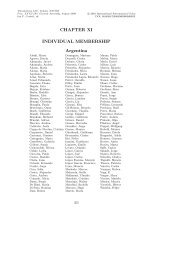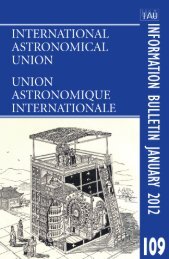IAU - INFORMATION BULLETIN No 84
IAU - INFORMATION BULLETIN No 84
IAU - INFORMATION BULLETIN No 84
- TAGS
- bulletin
- www.iau.org
Create successful ePaper yourself
Turn your PDF publications into a flip-book with our unique Google optimized e-Paper software.
<strong>IAU</strong> / <strong>INFORMATION</strong> <strong>BULLETIN</strong> <strong>No</strong> <strong>84</strong> file:///Users/luis/Desktop/IB/IB<strong>84</strong>.html<br />
Brian G. Marsden<br />
Director of the Bureau<br />
Commission 20<br />
<strong>No</strong>te: The web address of Comm. 20 is: http://www.astro.uu.se/<strong>IAU</strong>/c20 (error in IB 83, p. 6)<br />
Annual Report of the Minor Planet Center, 1998<br />
The number of pages of Minor Planet Circulars (MPCs) issued, 2368, was again very slightly less<br />
than in the preceding year, but this needs to be augmented by the 3028 pages of the Minor Planet<br />
Circulars Supplement (MPSs), a new series introduced in October 1997 to include the actual<br />
observations, which are now only summarized in the MPCs themselves. More than 70 percent of<br />
the MPCs therefore now refer to orbital computations, including the documentation of new<br />
numberings of minor planets. The 1701 new assignments of permanent numberings in 1998 is well<br />
over twice the previous record of 758 attained in 1997. Furthermore, the number of objects given<br />
provisional designations in a single halfmonth exceeded the previous record on no fewer than five<br />
occasions during 1998, sending the subscripted numerals beyond 100 for the first time. The record<br />
subscript reached, in the second half of September, 164, which translates into the multiple-night<br />
detection of more than 4100 objects that were not immediately identifiable. The total of Minor<br />
Planet Electronic Circulars (MPECs) issued, 743, was also more than twice as many as ever<br />
before. The main reason for this increase is the "Daily Orbit Update" (DOU) MPEC that lists all<br />
the orbits computed and identifications found since the previous issue. Nevertheless, even if these<br />
340 DOU issues are excluded - they do normally appear seven days a week, but there is an<br />
interruption for a few days each month while the MPCs are being prepared - there is a 34- percent<br />
increase over the previous record year of 1997. Subtraction of the DOU issues during the second<br />
halves of September and <strong>No</strong>vember still leaves more "traditional" MPECs, 33 and 31,<br />
respectively, than in any halfmonth in a previous year.<br />
The principal reason for the tremendously increased activity in 1998 has been the enormous<br />
success of the M.I.T. Lincoln Laboratory Near-Earth Asteroid Research (LINEAR) program, which<br />
"almost overnight" in March resulted in a fivefold increase in the production rate of observations.<br />
Although this increase meant the addition of 55 new "potentially hazardous asteroids" to the 104<br />
known at the end of 1997 (accumulated since 1932), it obviously applied also to the data on mainbelt<br />
objects. The LINEAR program also yielded at least 16 new comets in 1998. This number is<br />
undoubtedly an underestimate, because the short exposures used by LINEAR mean that comets are<br />
generally not recognized as such. Cometary nature therefore needs to be established by other<br />
observers. In this connection, "The NEO Confirmation Page" (NEOCP), maintained by the Minor<br />
Planet Center on the World Wide Web, has proven very valuable, because it is a place where<br />
objects whose motion (even on a single night) suggests NEO status are immediately placed, in the<br />
hope that observations obtained by others as a result will confirm this status. Since such<br />
observations are likely to show whether or not an object is cometary, the Minor Planet Center also<br />
sometimes uses the NEOCP for objects it suspects (either from an orbit determination or from a<br />
tentative report by an observer) to be comets.<br />
One area where activity was down during 1998 involved the transneptunian objects (TNOs or<br />
KBOs or EKOs), with only 15 new such objects actually reported during the year (four of them on<br />
images obtained during 1997). However, many additional TNOs from 1998 images were reported<br />
10 of 37 5/19/08 10:03 AM






